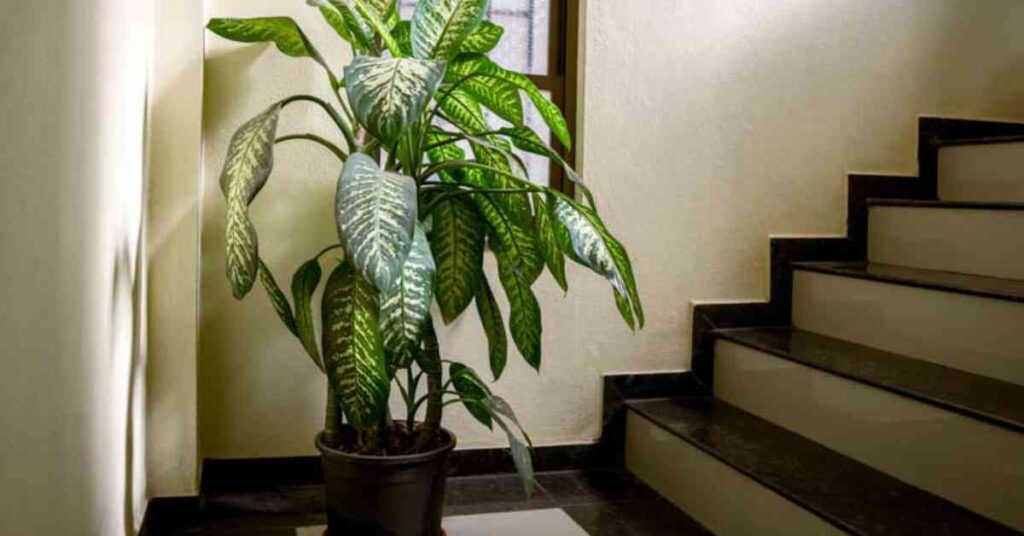
Introduction
Dieffenbachia, commonly known as dumb cane, is a popular houseplant known for its lush foliage and ease of care. Native to the tropical regions of Central and South America, this plant belongs to the Araceae family and is prized for its ornamental leaves, which are often variegated with striking patterns of green, white, and yellow. Dieffenbachia is not only an attractive addition to indoor spaces but also an air-purifying plant, making it a favorite among plant enthusiasts. In this comprehensive guide, we will explore everything you need to know about growing and caring for Dieffenbachia, including its varieties, ideal growing conditions, propagation methods, and common problems.
Varieties of Dieffenbachia
There are several popular varieties of Dieffenbachia, each with unique leaf patterns and colors. Some of the most well-known varieties include:
- Dieffenbachia seguine (Leopard Lily): Known for its large, dark green leaves with white or cream spots.
- Dieffenbachia amoena (Tropic Snow): Features wide, green leaves with creamy-white stripes along the veins.
- Dieffenbachia ‘Camille’: This variety has striking white leaves bordered by dark green edges.
- Dieffenbachia ‘Reflector’: Recognized for its dark green leaves with light green spots and a unique reflective quality.
- Dieffenbachia ‘Compacta’: A smaller variety with dense, compact growth and variegated leaves.
Each variety offers its own unique aesthetic, making it easy to find a Dieffenbachia that suits your indoor décor.
Ideal Growing Conditions
Dieffenbachia plants thrive in conditions that mimic their natural tropical habitat. Here are the key factors to consider for optimal growth:
Light
Dieffenbachia prefers bright, indirect light. While it can tolerate low light conditions, its growth may slow down, and the variegation on its leaves may fade. Avoid direct sunlight, as it can scorch the leaves.
Temperature
These plants thrive in temperatures between 65°F and 75°F (18°C to 24°C). They are sensitive to cold drafts and sudden temperature changes, so it’s best to keep them away from windows or doors that are frequently opened during colder months.
Humidity
Dieffenbachia enjoys high humidity levels, similar to its tropical origins. Regular misting or placing the plant on a humidity tray can help maintain the desired humidity levels. Using a humidifier can also be beneficial, especially in dry indoor environments.
Soil
A well-draining potting mix is essential for Dieffenbachia. A mix of peat, perlite, and regular potting soil works well. The soil should be kept consistently moist but not waterlogged.
Watering
Watering needs depend on the season. During the growing season (spring and summer), keep the soil evenly moist by watering regularly. In the dormant season (fall and winter), reduce watering and allow the soil to dry out slightly between waterings.
Propagation Methods
Dieffenbachia can be propagated through stem cuttings or division. Here’s how to propagate using each method:
Stem Cuttings
- Select a Healthy Stem: Choose a healthy stem with at least one or two nodes (the points where leaves emerge).
- Cut the Stem: Using a sharp, sterilized knife or scissors, cut the stem just below a node.
- Prepare the Cutting: Remove any lower leaves from the cutting, leaving a few at the top.
- Root the Cutting: Place the cutting in water or directly into a pot filled with moist potting mix. If rooting in water, change the water every few days to prevent stagnation.
- Transplant: Once roots have developed (usually within a few weeks), transplant the cutting into a pot with potting mix.
Division
- Remove the Plant from its Pot: Gently remove the Dieffenbachia from its pot.
- Separate the Clumps: Carefully divide the root ball into smaller sections, each with at least one stem and a healthy root system.
- Replant: Plant each division in its own pot with fresh potting mix.
Common Problems and Solutions
Yellowing Leaves
Yellowing leaves can be caused by several factors, including overwatering, underwatering, or nutrient deficiencies. Ensure you are watering appropriately and consider fertilizing the plant during the growing season.
Browning Leaf Tips
Browning leaf tips are often a sign of low humidity or over-fertilization. Increase humidity levels around the plant and reduce the frequency of fertilization.
Pests
Dieffenbachia can be susceptible to common houseplant pests such as spider mites, aphids, and mealybugs. Regularly inspect your plant for pests and treat infestations with insecticidal soap or neem oil.
Wilting
Wilting can be a sign of root rot caused by overwatering or poor drainage. Check the soil moisture levels and ensure the pot has proper drainage holes. Repot the plant in fresh, well-draining soil if necessary.
Toxicity
One important consideration when growing Dieffenbachia is its toxicity. The plant contains calcium oxalate crystals, which can cause irritation and swelling if ingested. This can be particularly dangerous for pets and small children. It is advisable to keep Dieffenbachia out of reach and handle the plant with care, especially when pruning or propagating.
Decorative Uses
Dieffenbachia’s attractive foliage makes it a popular choice for indoor decoration. Here are some ideas for incorporating Dieffenbachia into your home décor:
- Centerpiece: Place a large Dieffenbachia as a focal point in your living room or entryway.
- Tabletop Plant: Smaller varieties can be used as tabletop plants in kitchens, bathrooms, or offices.
- Plant Stands: Elevate the plant on a decorative stand to add height and visual interest to your space.
- Grouping: Combine Dieffenbachia with other tropical plants to create a lush, indoor jungle effect.

Conclusion
Dieffenbachia is a versatile and visually appealing houseplant that can add a touch of the tropics to any indoor space. With its striking variegated leaves and relatively easy care requirements, it’s no wonder that this plant remains a favorite among plant enthusiasts. By providing the right growing conditions, understanding its propagation methods, and addressing common problems, you can enjoy the beauty of Dieffenbachia for years to come. Just remember to handle it with care due to its toxicity, and you’ll have a thriving, healthy plant that enhances your home’s ambiance.
